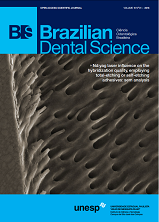Use of ozone therapy together to low power laser in osteonecrosis induced bisphosphonates - Clinical case
DOI:
https://doi.org/10.14295/bds.2016.v19i1.1138Abstract
Considering the probable causal association between the use of bisphosphonates and osteonecrosis of the jaw, as well as the high number of prescriptions and use these drugs every year, this paper aims to show different treatment. The combined use of ozone therapy and laser therapy in tissue regeneration and bone repair in patients with osteonecrosis induced by bisphosphonates, held by the discipline of Oral and Maxillofacial Surgery and Traumatology, Paulista State University "Júlio de Mesquita Filho". Female patient, white, 53 years after a breast cancer had an evolution for bone metastases throughout the body, and start the chemotherapy treatment using intra-venous pamidronate 90 mg monthly from 2007 which has been used to the present day, due to disease stabilization. The patient sought the institution complaining of painful symptoms in the mandible and maxilla, and the clinical examination and CT were diagnosed initial sites suggestive of osteonecrosis induced by bisphosphonates. In seeking to reduce the symptoms and clinical signs, to prevent progress in the lesions, we recommend treatment by ozone therapy together to infrared low-power laser, which showed satisfactory reduction in bone necrosis sites. Although there are wide variations and difficulties in treatments for osteonecrosis induced by bisphosphonates, it was possible regression of the lesions through the joint processing applied, and the improvement in life expectancy of the patient.Downloads
Downloads
Additional Files
Published
How to Cite
Issue
Section
License
Brazilian Dental Science uses the Creative Commons (CC-BY 4.0) license, thus preserving the integrity of articles in an open access environment. The journal allows the author to retain publishing rights without restrictions.
=================




























